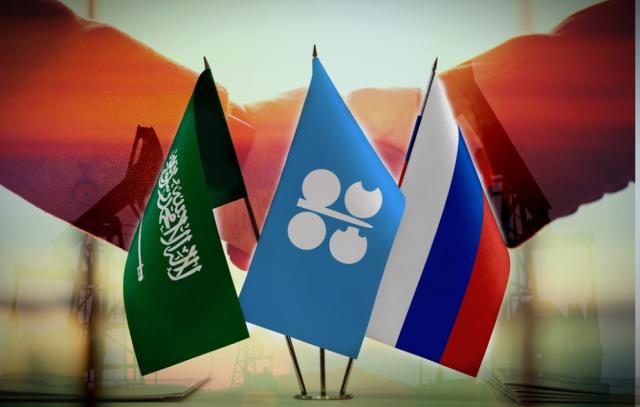
Saudi Arabia and Russia agreed between them to cut about 5 million bbl/d in oil production. (Source: Shutterstock.com)
OPEC and Russia agreed on April 9 to make deep cuts to oil production, ending a weeks-long market-share war that put further pressure on prices already reeling from the biggest demand collapse in history.
But the market reaction was punishing after details of the proposal—which by 9 p.m. in Vienna had not yet been formally agreed by OPEC ministers—emerged.
Global benchmark Brent reversed a near 11% rally to close down 4% at $31.48 a barrel. Traders doubted the cuts would make up for the fall in demand resulting from the coronavirus pandemic and questioned whether non-OPEC producers would contribute.
The oil producers agreed a production cut of 10 million bbl/d—by far the biggest supply deal in history and equivalent to roughly 10% of pre-crisis demand—following pressure from U.S. President Donald Trump. The cuts would diminish over time, ending in April 2022, according to the plan.
Saudi Arabia and Russia, the two biggest producers in the deal, agreed between them to cut about 5 million bbl/d. Other OPEC+ producers agreed to remove an additional 5 million bbl/d. The cartel called on the U.S. and Canada, among other countries, to cut another 5 million bbl/d when G20 energy ministers hold an extraordinary meeting on April 10.
While hopes for a global supply deal have supported prices for the past week, traders sold as the outcome became clearer, judging it would not be enough to offset the loss of nearly a third of global consumption as a result of lockdowns and travel bans. Global demand was more than 100 million bbl/d before the pandemic.
OPEC Secretary-General Mohammad Barkindo described coronavirus as an “unseen beast” that had created a “horrifying” supply and demand outlook for the oil industry “beyond anything we have ever seen before.”
Brent crude at one stage rallied to a high of $36.40/bbl shortly after the meeting started, on reports Russia and Saudi Arabia could lead the cartel in cuts of as much as 20 million bbl/d.
Instead, Riyadh and Moscow—which traded barbs in the days leading up to the videoconference—agreed after several hours discussion each to cut output by around 22%, from a baseline of 11 million bbl/d. Before the price war began, Saudi Arabia was producing about 9.7 million bbl/d, but swiftly ramped up supply to a record high of 12.3 million bbl/d.
“A 10 million bbl/d headline cut begs some hard questions,” said Bill Farren-Price at RS Energy Group. “The biggest one is—why would Russia and Saudi Arabia continue to underwrite the U.S. shale patch at considerable cost to their own exports and with little guarantee on the price impact of such a move? This will put even more pressure on the U.S. to pledge its own cuts tomorrow at the G20.”
The proposal would see the cuts gradually ease, with 10 million bbl/d removed through May and June, before cuts drop to 8 million bbl/d to the end of the year and 6 million bbl/d thereafter until April 2022.
The failure to prop up the market will spread further fear in an industry already struggling to adapt to a more than 50% drop in prices since the start of the year.
The U.S. shale sector faces widespread bankruptcies, while the wider industry fears forced shutdowns of production, which can cause long-term damage to fields. Storage capacity is predicted to be overwhelmed globally within months. Millions of jobs across the globe could be lost, while the budgets of poorer producers like Nigeria and Angola are decimated just as they need to fund their response to the pandemic.
In a statement on the decision by OPEC and Russia, Harold Hamm, executive chairman and founder of U.S. shale producer Continental Resources Inc., applauded the production cut as ”a good and necessary” first step to restore some sanity to global oil markets.
”We hope signals the recognition that dumping excess oil into the U.S. market is a losing proposition for all concerned,” Hamm said.
The shale energy executive with close ties to Trump told Financial Times in an interview on April 6 that U.S. producers were already shouldering some of the burden to cut crude oil output as the White House encourages Saudi Arabia and Russia to solve a worldwide petroleum glut by curtailing their own.
In his statement on April 9, Hamm noted that demand remains out of sync with supply as the world has lost almost 30 million bbl/d of demand.
“Here, in the United States, we are rapidly adjusting production to these new realities,” he said. “We hope that the oil-producing nations take additional steps soon to better align demand with supply.”
Trump put pressure on Russia and OPEC’s largest member Saudi Arabia to forge a pact to cut 10 million-15 million bbl/d of output, decrying a price war launched after the two fell out in early March over how to respond to the crisis. Both Riyadh and Moscow have insisted other countries, including the U.S., participate in the new deal.
U.S. benchmark WTI posted a peak-to-trough swing on April 9 of more than $5/bbl, hitting a high of $28.36 before falling to $23.24, down more than 5% on the day.
The U.S. has indicated that its own production is likely to fall anyway because of the precipitous drop in prices, but is not in a position to mandate cuts due to antitrust laws even if it desired too.
Russian officials had pushed back against what they saw as the U.S. and other countries such as Canada dressing up natural production declines, but have appeared to acquiesce to this reality on April 9.
The full details of the final deal, expected to be announced after the G20 meeting on April 10, have the potential to further unnerve markets with many traders fearing a diplomatic fudge.
Helima Croft at RBC Capital Markets said she expected any deal “will yield a broad framework agreement to curb output by a big headline number” but that it was likely to “be short on hard specifics such as duration, implementation timeline, and enforcement mechanisms.”
Part of the plan is to ask consuming countries at the G20 meeting on April 10 to contribute by buying up cheap oil for their strategic stockpiles, providing a boost to demand, and then including those barrels within a collective 15 million bbl/d target, according to people familiar with the talks.
Hart Energy contributed to this report.
Recommended Reading
E&P Highlights: Feb. 26, 2024
2024-02-26 - Here’s a roundup of the latest E&P headlines, including interest in some projects changing hands and new contract awards.
The OGInterview: How do Woodside's Growth Projects Fit into its Portfolio?
2024-04-01 - Woodside Energy CEO Meg O'Neill discusses the company's current growth projects across the globe and the impact they will have on the company's future with Hart Energy's Pietro Pitts.
Deepwater Roundup 2024: Offshore Australasia, Surrounding Areas
2024-04-09 - Projects in Australia and Asia are progressing in part two of Hart Energy's 2024 Deepwater Roundup. Deepwater projects in Vietnam and Australia look to yield high reserves, while a project offshore Malaysia looks to will be developed by an solar panel powered FPSO.
Deepwater Roundup 2024: Offshore Africa
2024-04-02 - Offshore Africa, new projects are progressing, with a number of high-reserve offshore developments being planned in countries not typically known for deepwater activity, such as Phase 2 of the Baleine project on the Ivory Coast.
Galp Seeks to Sell Stake in Namibia Oilfield After Discovery, Sources Say
2024-04-22 - Portuguese oil company Galp Energia has launched the sale of half of its stake in an exploration block offshore Namibia.




